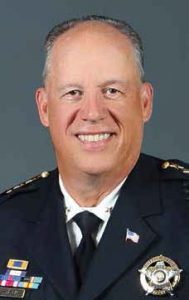Español Français Português عربى |
 Firearms violence has become all too common in countries around the globe. Whether experiencing targeted attacks, mass violence, or suicides, communities are shaken as they suddenly find themselves grieving the loss of those they care for. We undoubtedly have a long way to go in mitigating this violence, but we must remain persistent in our efforts to keep our communities safe.
Firearms violence has become all too common in countries around the globe. Whether experiencing targeted attacks, mass violence, or suicides, communities are shaken as they suddenly find themselves grieving the loss of those they care for. We undoubtedly have a long way to go in mitigating this violence, but we must remain persistent in our efforts to keep our communities safe.
In August of this year, Immediate Past President Paul M. Cell established a Targeted Violence Task Force to determine the factors that drive individuals to commit acts of violence and the steps that can be taken to prevent these acts and reduce both the severity and frequency of targeted violence. Over the last few months, the task force convened four times, hearing from panelists from a multitude of disciplines, including police, medicine, the private sector, and academia. These discussions focused on pathways to violence and warning signs, target hardening, harm reduction and mitigation, and preventing future attacks. While each participant brought his or her own perspectives and backgrounds, common themes were evident throughout. In the coming months, the IACP will turn this information into a living, breathing document to aid police chiefs worldwide before, during, and after mass casualty events. I believe this task force is the first step in helping police departments better prepare for, respond to, and cope when such situations occur in their communities.
In order to successfully combat firearms violence, it is essential that elected leaders take action to establish policies that can reduce the threat of firearms violence.
In concert with this, I will establish another task force, this time on Police Response to Active Threats. This group will build upon the work of the Targeted Violence Task Force and help to translate their findings into concrete actions that law enforcement agencies can take to combat active threats.
However, the solution to firearms violence is not only a law enforcement issue. In order to successfully combat firearms violence, it is essential that elected leaders take action to establish policies that can reduce the threat of firearms violence.
I am proud to say that the IACP has taken steps to promote background checks and extreme risk protection order legislation in the United States. There was a recent call to action to our membership to sign a letter, which was spearheaded by eight fellow chiefs and sheriffs who have seen firsthand the horrific toll of gun violence in their communities. The letter asks congressional leaders to take actions that will help keep guns out of the hands of dangerous individuals and combat interstate gun trafficking. States that have expanded the scope of their background checks have seen a decrease in gun violence, and those that have enacted extreme risk protection order laws have proven these orders to be an effective way for law enforcement to remove guns from a person in a mental health crisis, thereby preventing suicide and harm to others.
The IACP also opposes the public sale of body armor–piercing ammunition. As law enforcement officers continue to respond to shootings, they are now threatened by bullets capable of piercing the very vests they depend upon to save their lives. There is no reason for such ammunition to be produced, except for the intent to murder our brothers and sisters in the line of duty. The IACP is working hard to push for action that will further protect our law enforcement community and prohibit the manufacture of such ammunition.
As firearms violence continues to unfold, I believe it is equally important that we remain attentive to the training our officers receive in responding to such events. Training regarding mass casualty response, active shooters, crisis intervention, and de-escalation (to name just a few important topics) is invaluable and must be carried out on a consistent basis. Officer training not only improves critical decision-making during a crisis situation, but it can also help in the development of relationships internal and external to the department. Training that works across jurisdictions, as well as training that encompasses personnel from entities such as fire departments or medical facilities, helps ensure that crisis response runs smoothly when violence strikes.
Finally, I urge all police departments to use the National Integrated Ballistic Information Network (NIBIN). The ability of this system to analyze cartridge casing evidence against other images within the database, noting potential matches both within and across jurisdictions, is crucial to our success in mitigating firearms violence. As police leaders, we must realize the advantages of this database—its ability not only to link ballistic evidence to cases we were previously unaware of, but also to help in identifying patterns of firearm activity.
While it is my hope that someday we will see the end to such tragedies and loss, there is currently much to be done to improve the safety and well-being of our officers and communities as we work together to mitigate firearms violence. d
Please cite as
Steven R. Casstevens, “Responding to Firearms Violence,” President’s Message, Police Chief 86, no. 12 (December 2019): 6.


